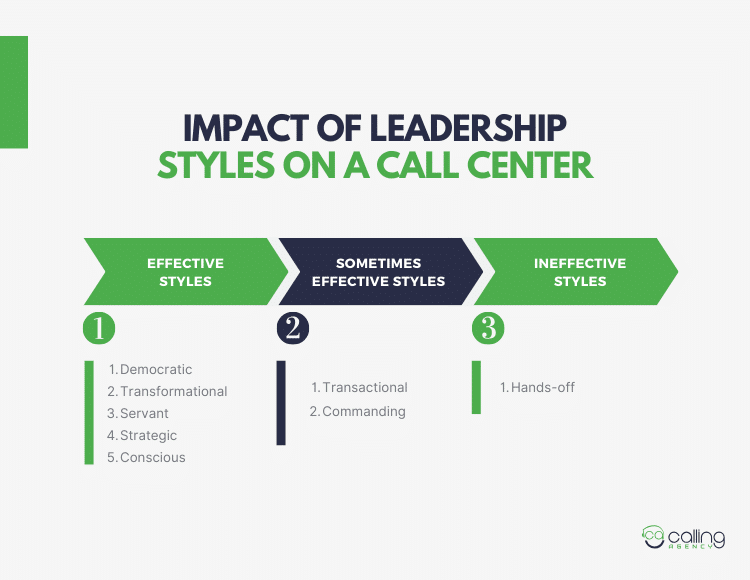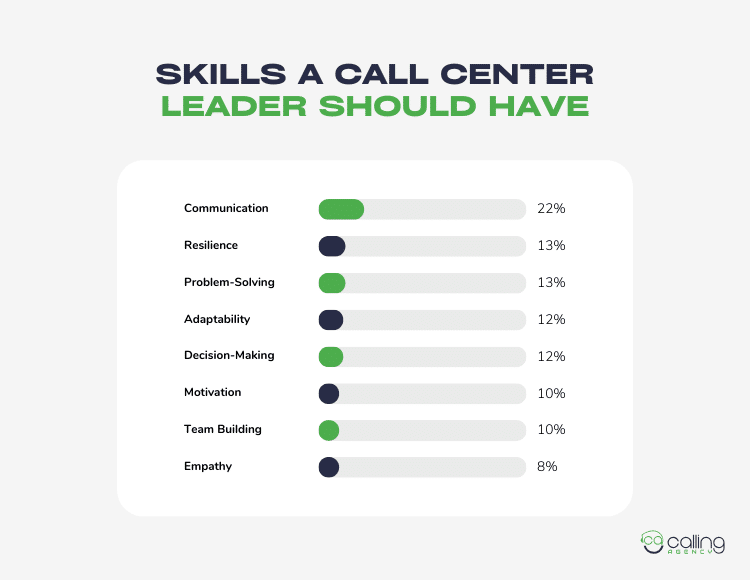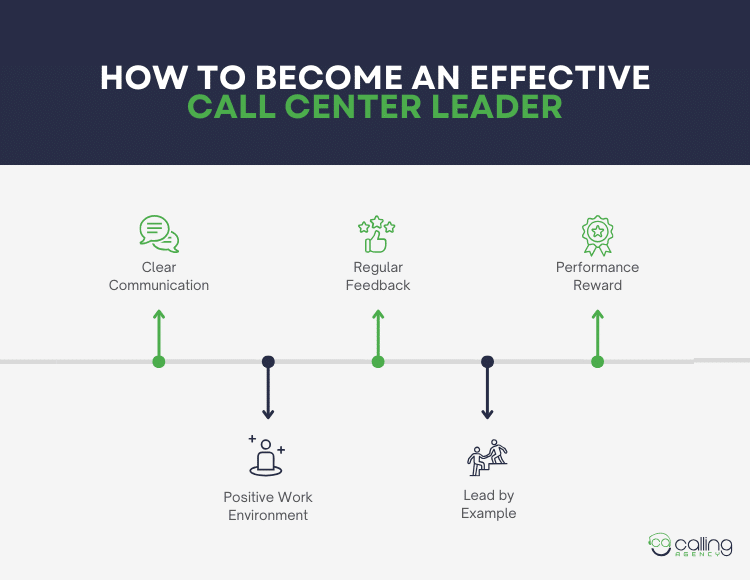Call center leadership styles are crucial for managing a team of agents effectively and maintaining customer service quality. But how do you determine what leadership style works best for your call center team? The answer depends on the needs and situation of your call center.
Leadership styles vary based on the organizational culture, the nature of the work, and the leader’s preferences. They have a significant impact on employee performance in a call center. Leaders need to adapt their approach based on the situation, team members’ individual needs, and the call center’s overall goals.
These styles help call center leaders improve agent engagement and deliver a great customer experience. So, choose the most suitable leadership style for your call center.
Let’s learn about the different leadership styles in a call center, the skills a leader should have, and how you can become an effective call center leader.

Democratic Leadership (Likely to Be Effective)
Also Called: Participative Leadership
Definition: Democratic leadership is a leadership style where leaders encourage and include team members in the decision-making process.
Pros:
- Democratic leaders increase the engagement and participation of team members by encouraging them to share their thoughts and ideas.
- By involving more people in decision-making, democratic leadership can lead to more diverse perspectives and, potentially, better decisions.
- Team members who feel heard are typically more satisfied and motivated.
Cons:
- The democratic process can be time-consuming, especially if there are many different opinions. It can slow down decision-making and reduce efficiency.
- While diverse perspectives can lead to better decisions, they can also lead to disagreements and conflicts within the team.
Overview
Democratic leaders share decision-making responsibilities with the team. This leadership style encourages open communication and staff participation in decisions. Democratic leadership helps to keep your agents satisfied and motivated. Satisfied agents improve service levels in a call center.
Potential Challenges
- Democratic leaders must balance seeking input from others and making timely decisions.
- This process can often lead to disagreements. Leaders will need to be skilled in conflict resolution.
- Participative leaders must find ways to maintain their authority while still promoting a democratic environment.
Transformational Leadership (Likely to Be Effective)
Also Called: Charismatic Leadership
Definition: Transformational leadership inspires and motivates agents to achieve their full potential and exceed expectations.
Pros:
- Transformational leaders inspire and motivate their team members, which can lead to increased productivity and job satisfaction.
- By encouraging and rewarding creativity, transformational leaders can promote an environment of innovation.
- Transformational leaders often focus on the big picture, which can help the team achieve its goals more effectively.
Cons:
- If team members become too dependent on the leader for inspiration and motivation, it could hinder their ability to work independently.
- Transformational leaders often set high standards and expect the best from their team, which could lead to stress and burnout if not appropriately managed.
Overview
A transformational leader works with the team to identify the needed change, creates a vision to guide the change through inspiration, and executes the change in collaboration with committed members of the group. It’s all about inspiring your team members to exceed their performance goals and contribute to their overall success.
Potential Challenges
- Transformational leaders need to ensure they’re providing enough support to their team to meet the high expectations they set.
- Charismatic leaders must continually reinforce the vision to motivate the team.
- The high expectations set by leaders could lead to burnout. Leaders must be aware of this risk and take steps to prevent it.
Servant Leadership (Likely to Be Effective)
Definition: Servant leadership is a leadership philosophy and style that highlights the leader’s primary role as a servant to their agents.
Pros:
- Servant leaders strongly focus on team members’ needs and well-being, which can lead to increased morale and satisfaction.
- Leaders can develop a collaborative and supportive work environment by prioritizing the team’s needs.
- Servant leaders often earn the trust and respect of their team, which can lead to improved agent performance.
Cons:
- The servant leadership style can be time-consuming, requiring a significant commitment to meeting individual team members’ needs.
- A servant leader’s efforts may sometimes be overlooked, as they often work behind the scenes supporting their team.
Overview
In servant leadership, the main goal of the leader is to serve. It is different from traditional leadership, where the leader’s main focus is the thriving of their company or organization. A servant leader shares power, puts the needs of the employees first, and helps agents develop and perform as highly as possible.
Potential Challenges
- Servant leaders need to strike a balance between serving their team and making critical leadership decisions.
- Leaders must ensure they also care for their needs to avoid burnout.
- Servant leaders may need to advocate for themselves to ensure their efforts are recognized and rewarded.
Transactional Leadership (Sometimes Effective)
Also Called: Managerial Leadership
Definition: Transactional leadership is a style of leadership where leaders rely on rewards and punishments to motivate and manage their agents and achieve optimal agent performance.
Pros:
- Transactional leadership provides clear structure and expectations to team members, which can be particularly beneficial in environments where tasks are routine or require strict obedience to guidelines.
- This leadership style often includes a system of rewards and punishments based on performance, which can motivate team members to achieve their goals.
- Transactional leadership can lead to high levels of efficiency as it provides a clear roadmap for what needs to be done and how to do it.
Cons:
- This leadership style can reduce creativity and innovation by focusing on following rules.
- Transactional leaders often focus on short-term goals rather than long-term strategic vision, limiting the organization’s growth potential.
Overview
Transactional leaders concentrate on overseeing, organizing, and enhancing group productivity. Leaders employing this approach concentrate on specific tasks and use rewards and punishments to motivate followers. This leadership style helps to improve call center agent performance and customer service quality.
Potential Challenges
- Transactional leaders need to ensure that their system of rewards and punishments is fair and motivating, not discouraging.
- While maintaining efficiency and order, transactional leaders also need to find ways to encourage creativity and innovation within their teams.
- This leadership style can sometimes lead to low employee engagement if team members feel they are only valued for their output, not their unique skills and contributions.
Strategic Leadership (Likely to Be Effective)
Also Called: Visionary Leadership
Definition: Strategic leadership involves effectively guiding and aligning the organization’s efforts toward achieving its long-term goals and objectives.
Pros:
- Strategic leaders have a clear vision for the organization’s future, which can help guide decision-making and set the direction for the organization.
- Leaders are often skilled at managing change, which can be crucial in today’s rapidly evolving business environment.
- By involving employees in strategic planning, strategic leaders can increase engagement and commitment to the organization’s goals.
Cons:
- Developing and implementing a strategic vision can be complex and challenging, requiring a deep understanding of the organization and its environment.
- As strategic leadership involves taking calculated risks, there is always the potential for failure.
- Strategic planning can be time-consuming and not feasible in all organizations or situations.
Overview
Strategic leaders express a strategic vision for the organization or a part of the organization, such as cold calling services. They also motivate and persuade others to acquire that vision. Strategic leadership can also be utilizing strategy in the management of employees. It has the potential to influence organizational members and execute organizational change.
Potential Challenges
- Strategic leaders must balance the need for immediate results with pursuing long-term goals.
- Visionary leaders must be able to communicate their vision to all levels of the organization effectively.
- Strategic leaders must be able to adapt their strategies as needed.
Commanding Leadership (Sometimes Effective)
Also Called: Coercive Leadership
Definition: Commanding leadership is a leadership style where the leader takes charge and provides clear direction to the team.
Pros:
- Commanding leaders can make decisions quickly without consultation or consensus. It can be particularly beneficial in situations that require immediate action or where there is a clear and correct course of action.
- Employees clearly understand what is expected of them, which can lead to increased efficiency.
- A commanding leadership style can be effective in times of crisis or emergency as it allows for swift action and decision-making.
Cons:
- Commanding leadership can lead to low employee morale and engagement, as employees have little to no say in decision-making.
- This leadership style can reduce creativity and innovation as it does not encourage input or ideas from team members.
- The lack of autonomy and involvement in decision-making can lead to high employee turnover.
Overview
Commanding leaders control all decisions and receive little input from group members. Commanding leaders typically make choices based on their ideas and judgments and rarely accept advice from followers. This leadership style involves absolute authority and unconditional compliance from employees.
Potential Challenges
- Commanding leaders must balance their authority with respect for their team members to avoid creating a hostile work environment.
- Commanding leaders may struggle to adapt to change as they are used to making decisions based on their ideas and judgments.
- Coercive leaders need to recognize when input from team members is necessary and beneficial.
Hands-off Leadership (Mostly Ineffective)
Also Called: Laissez-Faire Leadership
Definition: Hands-off leadership is an approach where leaders allow team members to make decisions and handle tasks with minimal supervision.
Pros:
- Hands-off leadership can lead to a high degree of autonomy for team members, which can motivate and increase job satisfaction.
- Hand-off leadership can foster creativity and innovation by allowing team members to make decisions.
- This leadership style can also help team members develop their leadership skills as they are given more responsibility.
Cons:
- Without clear guidance and direction from a leader, team members may feel unsure about what they should be doing, leading to inefficiency.
- With different team members making decisions, there can be inconsistency in how tasks are completed.
- If team members are not self-motivated or capable of working independently, hands-off leadership can lead to poor performance.
Overview
Hands-off leaders allow group members to make decisions. It can be effective when team members are highly skilled, motivated, and capable of working independently. However, it can lead to poor performance and lack of control if not managed correctly.
Potential Challenges
- Laissez-faire leaders need to find the right balance between giving team members autonomy and maintaining control over the team’s overall direction.
- While hands-off leaders give their team members a lot of autonomy, they still need to monitor performance and step in when necessary.
- Hands-off leaders must also ensure they provide enough support to their team members, even if they are not directly involved in day-to-day tasks.
Conscious Leadership (Likely to Be Effective)
Also Called: Mindful Leadership
Definition: Conscious leadership emphasizes self-awareness, ethical decision-making, and a deep understanding of the impact of leadership on the well-being of employees and the overall organizational culture.
Pros:
- Conscious leadership encourages leaders to understand their strengths and weaknesses, which can lead to personal growth and improved leadership skills.
- By leading with empathy and mindfulness, conscious leaders can create a positive and inclusive work environment.
- Conscious leadership can lead to enhanced relationships within the team, as leaders who are aware of their own emotions are better able to understand and respond to the emotions of others.
Cons:
- Conscious leadership requires high emotional intelligence, which not all leaders may possess.
- The self-awareness required for conscious leadership can be time-consuming.
- Some people may view conscious leadership as soft or lacking in decisiveness.
Overview
Conscious leaders are aware of themselves and their impact within the call center. It’s about recognizing your emotions and behaviors and understanding how they affect the people around you. Conscious leaders nurture an inclusive and positive work environment and lead with empathy and mindfulness.
Potential Challenges
- Developing the necessary skills for conscious leadership can be challenging for individuals who don’t possess high emotional intelligence.
- While empathy is a crucial component of conscious leadership, leaders also need to be able to make tough decisions, which can sometimes require setting empathy aside.
- Overcoming the decisiveness stereotypes can be a challenge for conscious leaders.
Skills or Traits A Leader Should Have?
Leadership skills are an essential component of every industry. A successful call center leader should possess several key traits. These skills or traits help a leader to manage their team effectively and ensure the smooth operation of their call center services.
Now, look into the essential skills and traits that a leader in a call center should have.

Communication: It is the most vital skill a leader should have. A leader with excellent communication skills can convey ideas clearly, listen actively, and provide productive feedback. Effective communication builds trust and understanding within a team.
Empathy: A good leader should be able to understand and share the feelings of their team. Agents often deal with stressed customers in a call center. A leader can help maintain team spirit and foster a positive and supportive work environment by showing empathy.
Decision-Making: Call centers are fast-paced environments where decisions must be made quickly. A good leader should be able to make informed decisions confidently and on time, even under pressure.
Motivation: A leader should not only be self-motivated but also can inspire motivation in others. It involves setting clear goals, providing positive reinforcement, and creating a work environment, encouraging growth and development.
Problem-Solving: In a call center, several problems may appear. A good leader should be able to think critically and develop effective solutions. It involves understanding the problem, generating possible solutions, and implementing the best one.
Adaptability: The ability to adapt to changes and handle unexpected situations is crucial in a call center. A good leader should be flexible and able to adjust their approach based on the situation at hand.
Resilience: Call centers can be stressful environments. A leader needs to remain calm and composed even in difficult situations. Resilience can help a leader navigate challenges and bounce back from setbacks.
Team Building: A good leader should be able to build a productive team where everyone works together towards a common goal. It involves encouraging a sense of relationship, resolving conflicts, and promoting collaboration.
Best Suitable Leadership Style in a Call Center
There is no definite suitable leadership style in a call center. Different leadership styles may work in different situations. However, democratic and transformational leadership are the two most appropriate leadership styles in a call center.
Democratic leadership encourages team members to contribute to decision-making. Democratic leaders ask for input from their agents and consider feedback from team members before deciding something.
This leadership style helps agents improve their skills. It also allows them to increase their engagement and job satisfaction. In a call center where collaboration and input from front-line staff can lead to improved processes and problem-solving, democratic leadership may be beneficial.
On the other hand, transformational leaders inspire their team members to exceed their individual performance goals and contribute to the team’s overall success. They do this by setting high expectations, providing support and feedback, and recognizing and rewarding good performance.
This leadership style can be particularly effective in a call center, where team members often need to work quickly and efficiently under pressure.
Both of the leadership styles are highly suitable for every call center. They help the agents of the call centers to be more skillful and provide the motivation to contribute much more to the success of the call center.
Also, try to apply other leadership styles to recognize the style that fits your work style. Look for opportunities to practice these styles to improve your call center’s agent engagement and customer experience.
Tips for Becoming an Effective Call Center Leader
Now that you know about the leadership styles for a call center and the skills a leader should have, you must learn how to become an effective call center leader. Let’s look at five tips for being an effective call center leader.

Communicate Clearly: Clear communication is the foundation of effective leadership. As a leader, you should ensure your team understands their roles, responsibilities, and performance expectations.
It includes setting clear goals, providing detailed instructions, and offering constructive feedback. Regular team meetings, one-on-one check-ins, and open-door policies can facilitate this communication.
Provide Regular Feedback: Feedback is essential for growth and improvement. Regularly provide your agents with both positive feedback on what they’re doing well and constructive feedback on areas for improvement.
Ensure your feedback is specific, timely, and actionable. The goal of feedback should be to help your team members become better at what they do, not to criticize.
Recognize and Reward Good Performance: Recognition and rewards can significantly boost morale and motivation. Celebrate your team’s successes, even if they’re small. It could be a shout-out in a team meeting or a note of appreciation. Also, consider implementing a rewards system to recognize outstanding performance.
Promote a Positive Work Environment: A positive work environment can reduce stress, increase job satisfaction, and improve performance. Promote a culture of respect and collaboration. Address conflicts promptly and fairly. Also, ensure your team has the resources and support they need to do their jobs effectively.
Lead by Example: As a leader, your team looks up to you and often mimics your behavior. Show them the kind of behavior and attitude you expect from them. It includes demonstrating a strong work ethic, maintaining a positive attitude, respecting all team members, and sticking to company policies and guidelines.
Final Thoughts
Leading a call center team can be challenging. However, applying suitable leadership styles can make it a rewarding experience. Leadership styles are a crucial aspect of telemarketing services that help boost your call center’s customer satisfaction rate.
The best leaders inspire their teams to be the best they can be. By adopting a leadership style and developing key leadership traits, you can help your team reach their full potential and contribute to the success of your call center.
Reading this article, you’ll be able to determine what leadership style works best for your call center. So, go for the ideal leadership style and develop yourself as an effective leader for your team.








